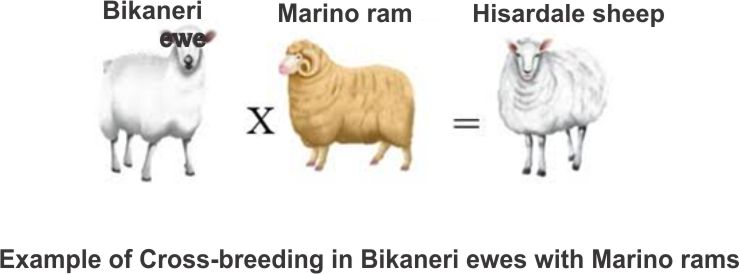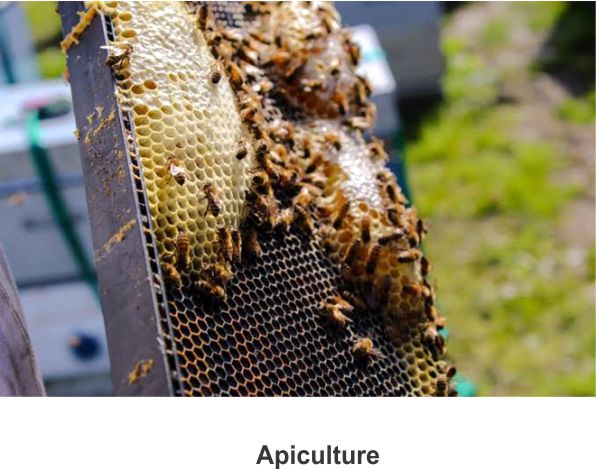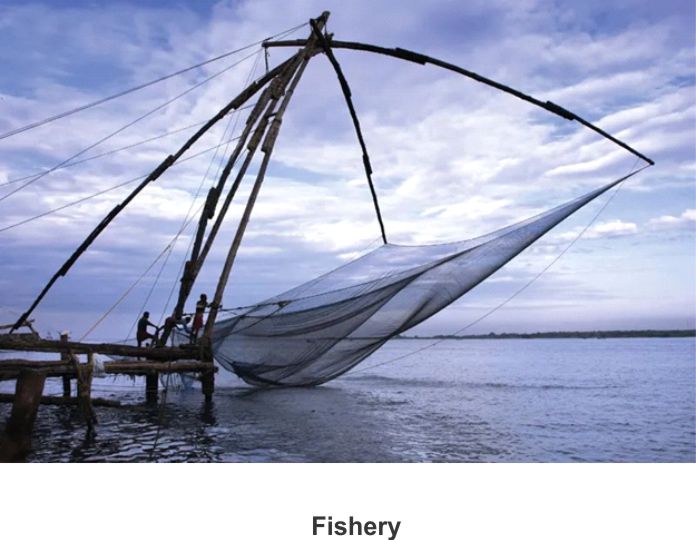ANIMAL HUSBANDRY
- Animal husbandry is an integral agricultural practice focused on breeding and nurturing livestock.
- It includes diverse animals like buffaloes, cows, pigs, horses, cattle, sheep, camels, and goats.
- Extends to poultry farming, fisheries (fish, mollusks, crustaceans).
- Humans historically used animals like bees, silk-worms, prawns, crabs, fishes, birds, pigs, cattle, sheep, camels.
- To derive essential products like milk, eggs, meat, wool, silk, and honey.
- India and China host over 70% of the world's livestock.
- Their combined contribution to global farm produce is only 25%.
- Animal husbandry yields products like milk, eggs, meat, wool, silk, honey.
- Low productivity per unit is a challenge.
- Integration of newer technologies crucial for improved quality and productivity.
- Balancing traditional practices with modern technologies is vital for addressing productivity gaps in animal husbandry.
Dairy Farm Management
- Dairying involves managing animals for milk and its products for human consumption.
- Cattle are central to a dairy, with breeds selected for high yield and disease resistance.
- Well-maintained conditions for cattle include proper housing, adequate water, and disease prevention.
- Milk yield depends on the quality of breeds.
- Selection of high-yielding breeds adapted to local climatic conditions is crucial.
- Feeding cattle should follow a scientific approach, emphasizing both quality and quantity of fodder.
- Paramount importance on cleanliness and hygiene during milking, storage, and transport.
- Modern mechanization minimizes direct contact of produce with handlers.
- Many dairy processes have become mechanized for efficiency and reduced human contact.
- Ensures product quality and safety.
- Stringent measures and regular inspections are essential.
- Proper record-keeping aids in identifying and rectifying problems promptly.
- Regular visits by a veterinary doctor are mandatory for animal health and well-being.
Poultry Farm Management
- Poultry refers to domesticated fowl (birds) used for food or eggs, including chicken, ducks, turkey, and geese.
- Primarily involves chicken and ducks, but the term can extend to meat from other birds.
- Similar to dairy farming, poultry farm management emphasizes:
- Selection of disease-free and suitable breeds.
- Maintenance of proper and safe farm conditions.
- Provision of appropriate feed and water.
- Implementation of hygiene and health care practices.
- Bird flu, or avian influenza, is a viral infection affecting domesticated fowl used for food or eggs.
- Commonly observed in chickens, ducks, turkeys, and geese.
- Incidents of bird flu trigger panic reactions, leading to a significant decline in egg and chicken consumption.
- Preventive Measures:
- Early Detection and Isolation:
Swift identification and isolation of infected birds are crucial.
Isolation prevents the rapid spread of the virus within flocks.
- Biosecurity Measures:
Implementation of strict biosecurity measures on poultry farms.
Restricted access, sanitation, and hygiene practices to prevent the introduction and spread of the virus.
- Monitoring and Reporting:
Regular monitoring for any signs of avian influenza.
Immediate reporting of suspected cases to relevant authorities.
- Education and Awareness:
Educate farmers and the public on preventive practices.
Awareness campaigns to emphasize the importance of biosecurity measures.
- Regular Veterinary Inspections:
Regular visits by veterinary doctors are essential for early detection of any health issues.
Prompt identification and rectification of problems contribute to overall flock health.
Animal Breeding
- Breeding is a fundamental aspect of animal husbandry, aiming to selectively propagate desirable traits in livestock.
- The process involves controlled mating to improve the quality and productivity of the offspring.
- The primary goal is to enhance the yield and improve desirable characteristics of the animals, tailoring them to specific agricultural purposes.
- Traits considered for breeding include yield, general appearance, features, size, and configuration.
- The choice of characters may vary depending on the type of animal and its intended purpose.
- A breed signifies a group of animals related by descent, sharing common traits like appearance, features, size, and configuration.
- Local research is essential to identify common breeds in the region.
- Breeding significantly contributes to the genetic improvement of livestock, enhancing productivity and adaptability to specific environmental conditions.
- Different breeds serve diverse purposes in agriculture, and breeding practices align with the intended use, whether for dairy, meat, or other agricultural products.
- Regular assessment of breeding programs is imperative to ensure progress.
- Adaptations are made based on changing agricultural needs and environmental conditions.
Inbreeding
- Inbreeding refers to the mating of more closely related individuals within the same breed for 4-6 generations.
- Superior males and females within the same breed are identified and paired for mating.
- Progeny from these matings are evaluated, and superior individuals are selected for further breeding.
- In cattle, a superior female is one that produces more milk per lactation.
- A superior male, or bull, is selected based on its ability to produce superior progeny compared to others.
- Similar to Mendel's strategy in developing homozygous purelines.
- Inbreeding increases homozygosity in animals.
- Homo = Same; Zygous = Gene loci.
- Homozygosity refers to the state of having identical alleles at corresponding gene loci on homologous chromosomes.
- Inbreeding exposes harmful recessive genes, which can be eliminated through selection.
- It accumulates superior genes and eliminates less desirable ones.
- Productivity of the inbred population is increased through careful selection at each step.
- Continued inbreeding, especially close inbreeding, may lead to reduced fertility and productivity known as inbreeding depression.
- To address fertility and productivity issues, selected animals should be mated with unrelated superior animals of the same breed.
- This practice helps restore fertility and yield.
Outbreeding
- Outbreeding refers to the breeding of unrelated animals, involving individuals with no common ancestors for 4-6 generations.
- Introduces genetic diversity into the population, countering the potential negative effects of inbreeding.
- Benefits of Outbreeding:
- Hybrid Vigor:
Results in hybrid vigor or heterosis, where the offspring may exhibit enhanced traits compared to the parent breeds.
- Increased Adaptability:
Greater adaptability to diverse environmental conditions due to increased genetic diversity.
- Reduced Expression of Recessive Alleles:
Dilutes the expression of harmful recessive alleles, reducing the risk of genetic disorders.
- Continuous monitoring and selection are crucial to maintain and enhance desirable traits while managing genetic diversity.
- Commonly employed in livestock farming to improve traits such as milk yield, meat quality, and disease resistance.
Outcrossing
- Out-crossing involves mating animals within the same breed but with no common ancestors up to 4-6 generations in their pedigrees.
- Ensures genetic diversity by avoiding shared ancestors within the specified generational range.
- The offspring resulting from such a mating is termed an out-cross.
- Ideal for animals with below-average productivity in traits like milk production or beef cattle growth rate.
- Particularly beneficial for overcoming inbreeding depression.
- A single out-cross can significantly contribute to overcoming the negative effects of inbreeding depression.
- Refreshing the gene pool reduces the risk of harmful recessive traits.
- Benefits of Out-crossing:
- Genetic Diversity:
Introduces genetic variability, mitigating the risk of recessive alleles and enhancing overall genetic health.
- Productivity Improvement:
Effective for below-average individuals, enhancing traits like milk production or growth rate.
- Commonly applied in livestock breeding, particularly for individuals with diminished productivity.
- Utilized to rejuvenate and diversify the genetic makeup of the population.
- Timing is crucial, and out-crossing is strategically employed when the need for genetic diversity arises.
- Continuous monitoring ensures that out-crossing aligns with breeding objectives and maintains genetic health.
- Selective breeding follows to retain desirable traits in the population.
Crossbreeding
- Cross-breeding involves mating superior males of one breed with superior females of another breed, aiming to combine desirable qualities from both breeds.
- Allows the integration of favorable traits from two different breeds, aiming for a hybrid that exhibits the best qualities of its parent breeds.
- Progeny from cross-breeding can be further subjected to inbreeding and selection to develop new stable breeds.
- This selective process aims to create breeds superior to the existing ones.
- Benefits of Cross-breeding:
- Trait Combination:
Results in hybrid offspring with a combination of desirable traits from both parent breeds.
- Improved Commercial Production:
Hybrid animals may be utilized for commercial production, capitalizing on the enhanced characteristics.
- Widely employed in livestock farming to enhance specific traits such as milk production, meat quality, or resistance to diseases.
- Genetic compatibility and the selection of superior individuals from each breed are crucial.
- Careful planning is necessary to maximize the benefits and avoid undesirable outcomes.
- Examples of Cross-breeding - Hisardale Sheep:
- Developed in Punjab by crossing Bikaneri ewes with Marino rams.
- Illustrates the success of cross-breeding in creating new, improved breeds.
- Cross-breeding contributes to genetic diversity, mitigating the risks associated with inbreeding and promoting overall population health.

Interspecific hybridization
- Interspecific hybridization involves mating male and female animals of two different but related species.
- The goal is to produce offspring that may combine desirable features from both parent species, potentially possessing considerable economic value.
- Example: The Mule:
- Mule Formation: One notable example of interspecific hybridization is the creation of the mule. A mule is the offspring of a male donkey (Equus asinus) and a female horse (Equus ferus caballus).
- Mules typically exhibit favorable traits such as strength and endurance inherited from donkeys, combined with the size and agility inherited from horses.
- Mules are often valued for their hardiness, strength, and utility in various tasks like agriculture and transportation.
- The hybrid vigor observed in mules is a result of interspecific hybridization.

- Another example of interspecific hybridisation is Liger which is an offspring of a female tiger and a male lion.
- Interspecific hybridization may pose challenges due to genetic differences between species.
- Fertility and viability of the offspring can vary, and some hybrids may be sterile.
- Beyond mules, interspecific hybridization is explored for potential economic benefits in agriculture, research, and other fields.
- Strategic selection of parent species is essential to maximize the desired characteristics in the hybrid offspring.
- Continuous breeding and selection contribute to the improvement of interspecific hybrids.
Artificial insemination
- Artificial insemination involves collecting semen from a chosen male and injecting it into the reproductive tract of a selected female by the breeder.
- Semen can be used immediately, frozen for future use, or transported to where the female is housed.
- Semen can be frozen and stored for extended periods, preserving the genetic material of superior males.
- Facilitates the use of genetic material even after the male is no longer available for natural mating.
- Advantages Over Natural Matings:
- Controlled Breeding:
Allows precise control over mating choices, ensuring desirable genetic traits are passed on.
- Overcoming Geographical Barriers:
Enables mating between animals located at a distance, overcoming geographical constraints. Facilitates the global exchange of elite genetic material, allowing breeders to access superior genetics from various locations.
- Selective Breeding:
Enhances the ability to select superior males for breeding. Allows breeders to choose males with specific desirable traits, contributing to genetic improvement.
- Disease Control:
Minimizes the risk of disease transmission that can occur through natural mating. Enables breeders to control and monitor the health status of the breeding animals.
- Optimized Timing:
Enables precise timing of insemination for maximum reproductive efficiency. Overcomes challenges associated with natural mating, where timing can be unpredictable.
- Ensures a consistent and standardized approach to breeding, minimizing variability associated with natural mating.
- Enhances overall productivity in animal husbandry.
Multiple ovulation embryo transfer technology(MOET)
- In situations where the success rate of crossing mature male and female animals is low despite artificial insemination, additional techniques like Multiple Ovulation Embryo Transfer Technology (MOET) are employed.
- MOET Process:
- Hormone Administration:
Cows are administered hormones with FSH-like activity to induce follicular maturation and superovulation. Instead of the usual one egg per cycle, cows produce 6-8 eggs.
- Mating or Artificial Insemination:
The superovulated cow is either mated with an elite bull or artificially inseminated.
- Embryo Recovery:
Fertilized eggs at 8–32 cell stages are recovered non-surgically.
- Transfer to Surrogate Mothers:
Recovered embryos are transferred to surrogate mothers for gestation.
- Repeat Superovulation:
The genetic mother is available for another round of superovulation, allowing for multiple cycles of embryo production.
- Applications Across Species: MOET technology has been successfully demonstrated in various species, including cattle, sheep, rabbits, buffaloes, mares, etc
- Benefits for Herd Improvement:
- Increased Offspring Production:
Enables the production of multiple offspring from a single female in a short period.
- Genetic Enhancement:
Elite genetic material can be strategically used to enhance desirable traits in the herd.
- Accelerated Herd Growth:
High milk-yielding females and quality meat-yielding bulls have been bred successfully, accelerating herd size growth.
- Role in Livestock Industry:
- Diversity and Quality:
Enhances genetic diversity and ensures the quality of livestock, contributing to the improvement of overall herd genetics.
- Economic Implications:
- Efficiency and Productivity:
MOET technology increases reproductive efficiency, allowing for rapid herd expansion and improved productivity.
Economic benefits are derived from enhanced traits, such as high milk yield and quality meat.
Bee keeping
- Bee-keeping, or apiculture, involves the maintenance of honeybee hives for honey production, beeswax, and various industrial uses.
- Products of Bee-keeping:
- Honey:
A highly nutritious food with applications in indigenous medicine.
- Beeswax:
Utilized in industries, such as cosmetics and various polishes.
- Increased demand for honey has transformed bee-keeping into an established income-generating industry, suitable for both small-scale and large-scale practices.
- Bee-keeping can be practiced in areas with sufficient bee pastures, including wild shrubs, fruit orchards, and cultivated crops.
- Beehives can be kept in various locations, including courtyards, verandahs, or rooftops.
Bee-keeping is not labor-intensive, making it accessible.
Apis indica is the most common honeybee species reared for bee-keeping.
Key Success Factors in Bee-keeping:
- Knowledge Base:
Understanding the nature and habits of bees is crucial.
- Location Selection:
Choosing suitable locations for beehives is essential.
- Swarm Management:
Efficient catching and hiving of bee swarms.
- Seasonal Hive Management:
Proper management during different seasons.
- Harvesting Practices:
Skillful handling and collection of honey and beeswax.
- Bees play a vital role as pollinators for numerous crop species (e.g., sunflower, Brassica, apple, and pear).
- Placing beehives in crop fields during flowering periods enhances pollination efficiency, benefiting both crop and honey yields.
- Bee-keeping, while relatively easy, requires specialized knowledge.
- Several organizations offer educational programs to teach bee-keeping.
- Bee-keeping is a sustainable and economically viable practice with ecological benefits, contributing to both food production and income generation.

Fisheries
- Fishery is an industry dedicated to the catching, processing, or selling of fish, shellfish, or other aquatic animals.

- A significant portion of the population relies on fish, fish products, and aquatic animals like prawns, crabs, lobster, and edible oysters for food.
- Freshwater Fishes: Catla, Rohu, and common carp are commonly found and consumed.
- Marine Fishes: Hilsa, Sardines, Mackerel, and Pomfrets are popular choices.
- Fisheries play a vital role in the Indian economy, providing income and employment to millions, particularly in coastal states.
- For many, it serves as the primary source of livelihood.
- To meet growing demands, various techniques, such as aquaculture and pisciculture, have been employed to increase aquatic plant and animal production.
- Pisciculture: Involves the breeding and rearing of fish.
- Aquaculture: Encompasses the cultivation of both aquatic plants and animals, including fish, in controlled environments.
- The adoption of aquaculture and pisciculture has significantly boosted the fishery industry's development, bringing substantial income to farmers and the country as a whole.
- 'Blue Revolution': Similar to the 'Green Revolution,' the 'Blue Revolution' signifies the transformation and enhancement of fisheries through modern techniques.
- Fisheries and aquaculture play a crucial role in addressing food needs, economic development, and livelihoods.